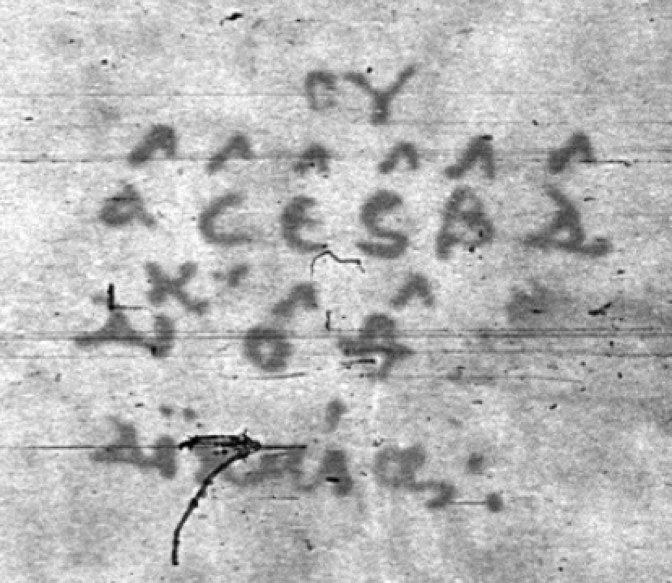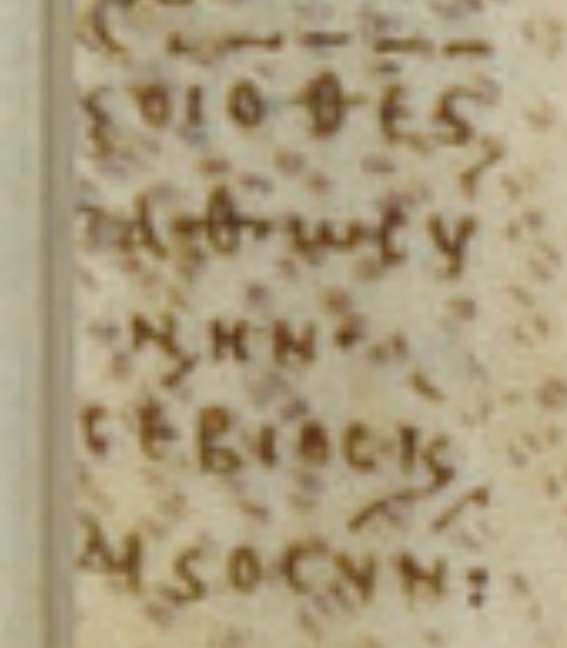
A Partly Solved Riddle: The Sigla β′ and δ′ in Hexaplaric Context
Felix Albrecht
August 31, 2025
In the course of my work on the Greek Psalter, I came across a detail that seems worth sharing in this brief post. I have been examining Ra 111 (early tenth century), a manuscript with striking hexaplaric marginal notes. Ra 1798 (fourteenth century) is a copy of Ra 111. That it is indeed a copy becomes apparent at once if one compares the unusual, identical title of the Psalter in both manuscripts, which incorporates a liturgical rubric:
ψαλτήριον α′ β′ ἁλληλούϊα.1

Ra 111, f. 11r

Ra 1798, f. 18r
Beyond this, both manuscripts preserve the same hexaplaric marginal scholia.2 The very first scholion on Ps 7:10–11 illustrates the point and raises the questions that follow. The scholion looks as follows:
| Ps 7:10f. | |
 |
 |
| Ra 111, f. 15r | Ra 1798, f. 20r |
The scholion comments on δικαίως in Ps 7:10–11 (I return below to the—debatable—wording and colometry of the passage). In Ra 111 the biblical text reads:
| 10 |
συντελεσθήτω δὴ πονηρία ἁμαρτωλῶν, |
Do let evil of sinners be brought to an end, |
| 11 | ἡ βοήθειά μου παρὰ τοῦ θ(εο)ῦ τοῦ σῴζοντος τοὺς εὐθεῖς τῇ καρδίᾳ. |
My help is from God, |
The scholion reads: α′ σ′ ε′ ς′ β′ δ′ δίκαιος, ο′ θ′ δικαία.
What is startling is the length of the hexaplaric sigla. The groups α′ σ′ ε′ ς′ and ο′ θ′ are familiar; but what are β′ and δ′? This scholion therefore prompts several questions.
1. Field, Montfaucon, and Δ versus Λ
Frederick Field (following Montfaucon) discusses, in connection with Ps 37:21, a scholion in Ra 190, f. 29r that appears to use the siglum Delta (δ′). He cites it as:
‘Ὠριγένης καὶ Ο′. Θ. Ε′. S′. ἀγαθοσύνην. Εὐσέβιος καὶ Δ. δικαιοσύνην’ (sic; Field I, p. xciv).
A look at the manuscript shows that the inner margin is not fully legible in the available images (both the colour photographs on Gallica and the older microfilm). What I can see is only:
 |
[Ὠριγένης] καὶ οἱ ο′ θ′ ε′ ϛ′ [ἀ]γαθωσύ νην· [Εὐ]σέβιος καὶ [δ′] δικαιοσύνην: |
| Ra 190, f. 29r | |
We must, then, rely on Montfaucon that the manuscript indeed reads ‘Εὐσέβιος καὶ δ′ δικαιοσύνην’. Field evaluates this as follows (in Norton’s translation): ‘However in this place, as also in the preceding places, we have easily accepted that Δ is nothing other than a badly written Λ (Λουκιανὸς)’ (sic; Norton, p. 175).
As for the witnesses at the locus, the overwhelming majority read ἀγαθωσύνην (or the orthographic variant ἀγαθοσύνην), and only three witnesses read δικαιοσύνην, i.e. the reading attributed in Ra 190 to Eusebius and the enigmatic Delta (or, if Field is right, Lambda): Ra B (4th c.), Ra 1219 (4th/5th c.), Ra 27 (8th c.). Is this truly the Eusebian reading and also the Lucianic reading? In my view, the patristic tradition answers ‘yes’ rather clearly:
-
In the Eusebian tradition the variant δικαιοσύνην for ἀγαθωσύνην is in fact attested, namely in Cod. Vaticanus gr. 2053, ff. 135–140 (s. IX ex.–X in.; siglum “h85”). In the BBAW preliminary edition (ed. Barbara Villani) the lemma is ἀγαθωσύνην, but this likely reflects the fact that the biblical text so far simply follows Rahlfs, i.e. it has not yet been critically reconstructed.3
-
There are good reasons to regard δικαιοσύνην as a Lucianic–Antiochene reading (the L‑Text).4 As for Diodore of Tarsus, one may question Olivier’s choice of ἀγαθωσύνην as lemma and instead elevate the variant δικαιοσύνην (Ra 769) to lemma.5 Diodore’s biblical text is a problem of its own, however. Theodore of Mopsuestia unequivocally reads δικαιοσύνην.6 Finally, Theodoret originally also reads δικαιοσύνην (MSS Ra 9002, 9026, 9050, 9078).7
Field’s explanation is thus plausible: in the scholion of Ra 190 on Ps 37:21, we should read Εὐσέβιος καὶ Λ′ δικαιοσύνην, with Λ standing for Λουκιανός, i.e. the Lucianic text (L‑Text in modern nomenclature).
2. A Glance at Ps 24:14a (Ra 190)
Regrettably Ra 190 begins only at Ps 17:36d, so it cannot be used for Ps 7:10–11. It does, however, seem to belong to the same tradition as Ra 111. This is clear from a helpful side‑glance at Ps 24:14a, where Ra 190 (f. 10r) notes: α′ σ′ ε′ αὐτοῖς: θ′ β′ αὐτῶν:
 |
| Ra 190, f. 10r |
Field cites Montfaucon’s remark: ‘Quid autem sibi velit illud Β. ignoramus.’8 Indeed β′ remains puzzling. Other hexaplaric witnesses read, according to Field, θ′ϛ′ αὐτῶν. For Ps 24:14a, then, β′ may well be a misreading of ϛ′ (stigma). For Ps 7:10–11, however, this explanation is unlikely, because ϛ′ (for the Sexta) already precedes β′ in the sequence α′ σ′ ε′ ς′ β′ δ′. A double citation of the Sexta would be odd.
Another possibility is that, as in Ra 190 at Ps 37:21, we have here a reference to Eusebius and Lucian: β′ would again be a corruption, and this would best explain the juxtaposition β′ δ′. In other words, we might have a deformed Εὐσέβιος καὶ Λουκιανός. Can this be corroborated from Eusebius’ commentary on the Psalms and from the Lucianic–Antiochene text of the Psalter?
3. Back to Ps 7:10–11
Rahlfs (4th ed. 2025)9 and NETS present the text as follows:
| 10 |
συντελεσθήτω δὴ πονηρία ἁμαρτωλῶν, |
Do let evil of sinners be brought to an end, |
| 11 |
δικαία ἡ βοήθειά μου παρὰ τοῦ θεοῦ |
Righteous is my help from God, |
The manuscript tradition generally differs in colometry, and the wording is often that found in Ra 111 above: ἐτάζων καρδίας καὶ νεφροὺς ὁ θεὸς δικαίως. ἡ βοήθειά μου παρὰ τοῦ θεοῦ […]. Three notable variants are attested overall:10
| δικαία | B 27 55 156 181* 1044 1062 1206 1081 1137 1156 1186 1188 1189 1191 1193 1830S ἐτάζων καρδίας καὶ νεφροὺς ὁ θεός. δικαία ἡ βοήθειά μου παρὰ τοῦ θεοῦ […] |
| δίκαιος | 130 152 211 226 270 280 283 1007 1010 1011 1030* 1058 1069 1088 1123 1162 1197vid 1202 1228C 1242* 1095var.lect. 1112 1116 1121 1178 1207 1218 1450 1511 1514 1735 1803 var.lect. 1814 1826 1827 1869 1895 ἐτάζων καρδίας καὶ νεφροὺς ὁ θεὸς δίκαιος. ἡ βοήθειά μου παρὰ τοῦ θεοῦ […] |
| δικαίως | rel. ἐτάζων καρδίας καὶ νεφροὺς ὁ θεὸς δικαίως. ἡ βοήθειά μου παρὰ τοῦ θεοῦ […] |
The reading δικαίως has the strongest support. From it one can readily explain δίκαιος as the lectio facilior, a case‑number‑gender alignment with ὁ θεός, facilitated by the common quantity interchange ω ⟷ ο.
According to the hexaplaric note on Ps 7:10–11, the distribution is:
δίκαιος α′ σ′ ε′ ς′ β′ δ′
δικαία ο′ θ′
Is there an analogy with the case at Ps 37:21? Put differently: where do Eusebius and Lucian stand at this passage? From Eusebius’ commentary (Fragment 5 on Ps 7), it is, in my view, clear that Eusebius read δίκαιος, as he comments:
αὐτός ἐστιν περὶ οὗ καὶ νῦν λέλεκται ἐτάζων καρδίας καὶ νεφροὺς ὁ θεὸς δίκαιος.11
This would allow β′ to point to Eusebius.
What, then, of δ′? Is this again a miswriting of Λ? Here the Lucianic–Antiochene text must decide:
There are good reasons, in my view, to regard δικαία as the Lucianic–Antiochene reading (L‑Text).12 Regarding Diodore of Tarsus, one may again question Olivier’s choice of δικαίως (Ra 1131 and Cod. Messanensis Bibl. Univ. S. Salvatoris gr. 38) as lemma and instead elevate δικαία (Ra 9055), since Diodore comments:
ἐπίστασαι ὅτι δικαίαν αἰτῶ τὴν βοήθειαν παρὰ σοῦ […],
which presupposes δικαία.13 What Theodore of Mopsuestia read is unfortunately unclear, as his biblical text is abbreviated.14 Theodoret, however, originally reads δικαία (MSS Ra 9026, 9044, 9049, 9051).15 Theodoret’s wording makes this plain:
Ὁ τοίνυν, φησὶ, τοὺς κεκρυμμένους τῆς διανοίας τῶν ἀνθρώπων λογισμοὺς ἐπιστάμενος, δικαίαν μοι παρέξει βοήθειαν, ἅτε δὴ τοῦτο ποιεῖν εἰωθώς.
The L‑Text thus reads δικαία and moves it to the beginning of v. 11.
Consequently, in the hexaplaric note on Ps 7:10–11, Δ′ cannot be a mere miswriting of Λ′ denoting the Lucianic recension or the others (οἱ λοιποί). The riddle of α′ σ′ ε′ ς′ β′ δ′ alongside ο′ θ′ is therefore not so easily resolved.
4. A Working Hypothesis—and Its Limits
Scholarship has considered other possibilities. One is to treat δ′ as a group siglum for four Hexaplaric columns (οἱ δ′ = ‘the four’). On this view, two notes may have been conflated: α′ σ′ ε′ ς′ on the one hand and β′ δ′ on the other. β′ would, as suggested above, point to Eusebius, while δ′ would indicate a set of four witnesses (α′ σ′ ε′ ς′). This solution is, however, not wholly satisfying. 16
Thoughtful suggestions are most welcome.
Summary
In Rahlfs’ edition of the Septuagint Psalter, the Lucianic–Antiochene text is not easy to discern. One reason is the unfortunate siglum L which—following Field and Lagarde—denotes one of the principal LXX recensions, the so‑called Lucianic recension.17 Already a millennium ago this tradition was sometimes cited in the Psalter catenae under the siglum Λ (Λουκιανός), which was at times misread as Δ. In that sense Λ was as ill starred a choice as L is in Rahlfs’ edition. There remain cases, however, where Δ cannot be securely resolved. One such instance is the tradition in Ra 111 at Ps 7:10–11, presented here.
-
Ra 111, f. 11r; Ra 1798, f. 18r. The small Greek numerals α′ and β′ here signify ‘first’ and ‘second’; together with ἁλληλούϊα they indicate the first and second antiphon (or group) with the refrain ‘Hallelujah’. This notation pertains to the ecclesiastical (Constantinopolitan) performance practice of the Psalms rather than to the textual transmission proper. Cf. G.R. Parpulov, Toward a History of Byzantine Psalters ca. 850–1350 AD, Plovdiv 2014, Appendix D1: Titles of Greek Psalter Manuscripts.↩
-
Cf. the marginal scholion on Ps 7:10b (Ra 111, f. 15r; Ra 1798, f. 20r) as well as the marginal scholion on Ps 24:14a (Ra 111, f. 33r; Ra 1798, f. 28r).↩
-
The MSS h23, h40, h88, h103, h146, and h177 read ἀγαθωσύνην, whereas h85 reads δικαιοσύνην. Cf. PTA.↩
-
On the definition of the L-text, cf. Psalmi cum Odis edidit Alfred Rahlfs, supplementum adiecit Felix Albrecht (Septuaginta. Vetus Testamentum Graecum auctoritate Academiae Scientiarum Saxoniae Inferioris Gottingensis editum X), Göttingen 42025, 388–401.↩
-
J.-M. Olivier: Commentarii, Diodori Tarsensis Commentarii in Psalmos vol. I, Commentarii in Psalmos I–L (CChr.SG 6), Turnhout 1980, 233.↩
-
Ed. R. Devreesse: Le commentaire de Théodore de Mopsueste sur les Psaumes (I–LXXX) (StT 93), Città del Vaticano 1939, 230. Likewise the Latin translation of Julian of Eclanum, ed. L. De Coninck: Theodori Mopsuesteni Expositionis in Psalmos Iuliano Aeclanensi interprete in latinum versae quae supersunt (CChr.SL 88A), Turnhout 1977, 178 (iustitiam).↩
-
The original lemma text of Theodoret’s commentary is preserved only in these three manuscripts. By contrast, the vulgar text, attested by all the other Theodoret manuscripts, reads ἀγαθωσύνην.↩
-
F. Field: Origenis Hexaplorum quae supersunt sive veterum interpretum Graecorum in totum Vetus Testamentum fragmenta vol. 2, Oxford 1875, 123, n. 25.↩
-
A. Rahlfs: Psalmi cum Odis 42025 (see above, fn. 4).↩
-
A simple error is the reading δικαίας in Ra 113 (f. 29v, last line), which is likely to have arisen from δικαίως. Ra 113 reads: ἐτάζων καρδίας καὶ νεφρούς ὁ θεὸς δικαίας. I mention this reading because, in theory, δικαίας could be taken as referring to καρδίας καὶ νεφρούς.↩
-
In the preliminary edition of the BBAW (ed. Barbara Villani, cf. PTA), δικαία has been chosen as the lemma; at this stage, however, this is only because the biblical text has not yet been critically reconstructed.↩
-
For the definition of the L-text, see above on Ps 37:21; cf. also A. Rahlfs, Psalmi cum Odis ⁴2025 (see above, fn. 4), 388–401.↩
-
J.-M. Olivier: Commentarii (see above, fn. 5), 40. The poorly reconstructed biblical text of Diodore by Olivier is— as already noted in the case of Ps 37:21— a problem in its own right.↩
-
Ed. R. Devreesse: Commentaire (see above, fn. 6), 40. Likewise the Latin translation of Julian of Eclanum, ed. L. De Coninck: Expositio in Psalmos (see above, fn. 6), 36: Scrutans corda et renes Deus (v. 10) usque corde (v. 11 fin.)↩
-
The original lemma text of Theodoret’s commentary is preserved only in these four manuscripts. By contrast, the vulgar text, attested by all the other Theodoret manuscripts, reads δικαίως (Ra 9016, 9017, 9035, 9039, 9050c, 9052, 9074, 9075, 9076, 9077). In addition, the sparsely attested reading δίκαιος (Ra 9050*, 9053) can be explained as a scribal error resulting from a confusion of quantity (ω ⟷ ο).↩
-
The assumption—already rejected in principle by Field—that Delta here refers to the Tetrapla is, in my view, difficult to sustain. At present I see no evidence for it. Further research into the hexaplaric transmission of the Psalter may, however, shed more light on this question.↩
-
Rahlfs’ use of the siglum L proves to be misleading: in most cases it does not denote the genuine Lucianic–Antiochian text, but rather the vulgar majority text. To avoid this confusion, I have proposed adopting the siglum K (Koine), familiar from New Testament textual criticism, and reserving it for the vulgar text. As a result, L should be used exclusively for the genuine Lucianic–Antiochian text, as it can be reconstructed from John Chrysostom, Theodore of Mopsuestia, and Theodoret of Cyrrhus, whereas K should designate the later common text. Cf. A. Rahlfs, Psalmi cum Odis ⁴2025 (see above, fn. 4), 388–401.↩
by Bonifatia Gesche, December 23, 2025
by Matteo Domenico Varca, November 30, 2025
by Anna Kharanauli, October 31, 2025
by Jonathan Groß, September 26, 2025
by Felix Albrecht, August 31, 2025
by Vadim Wittkowsky, July 31, 2025
by Bradley Marsh, June 30, 2025